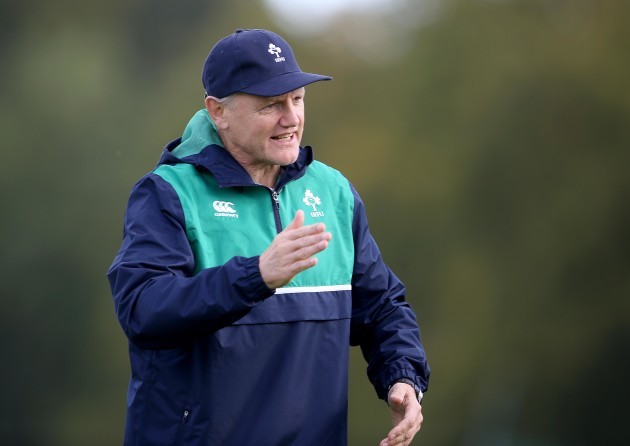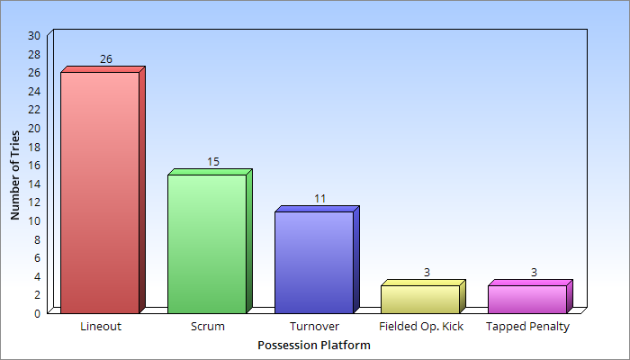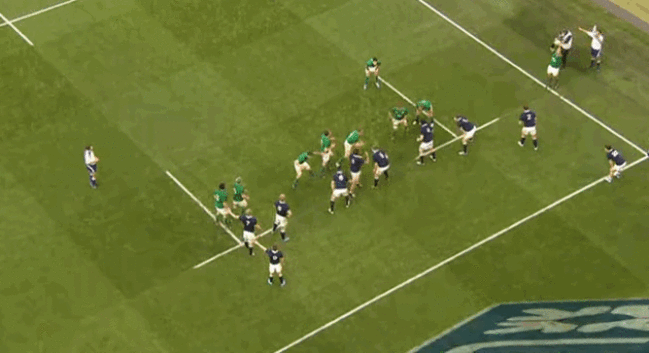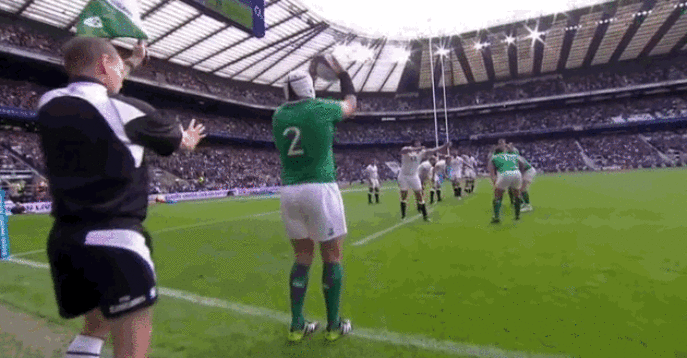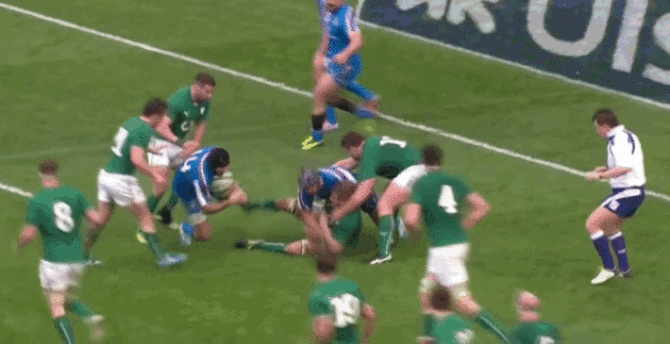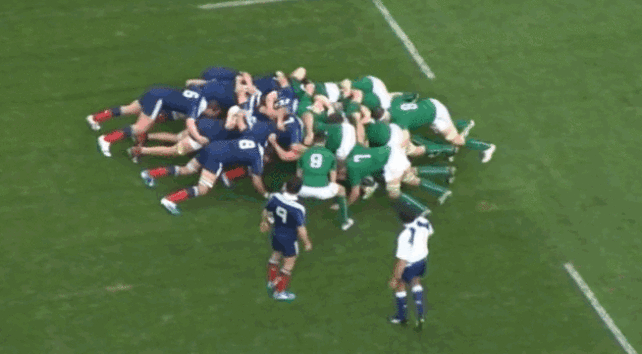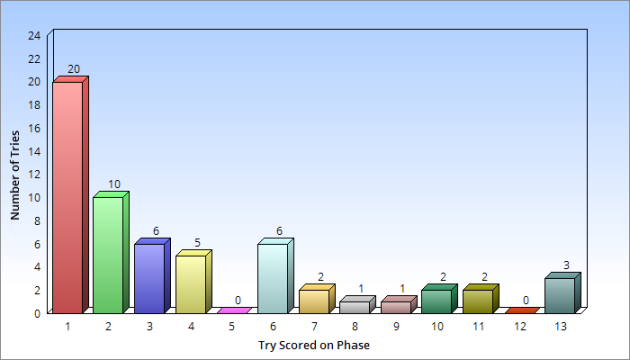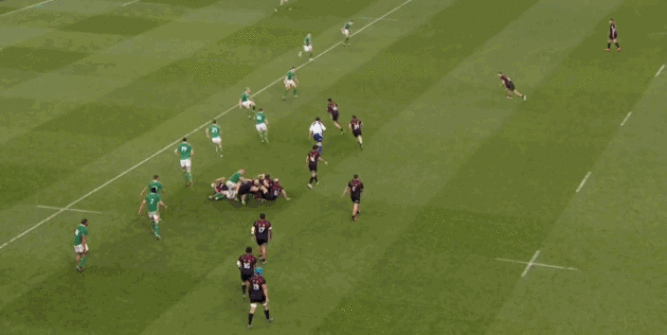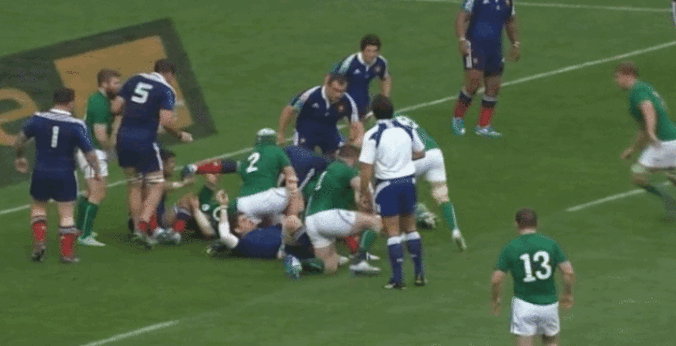IRELAND HAVE SCORED 58 tries in Joe Schmidt’s 22 Tests in charge, and they’ll need several more of them if they are going to earn a first-ever World Cup semi-final in the coming weeks.
While penalties and drop goals are certain to be crucial in the tighter games ahead, Ireland’s two opening pool matches against Canada and Romania are likely to provide many try-scoring opportunities.
The attacking side of the game is the one area where there have been doubts around Schmidt’s side, but getting over the tryline hasn’t always been a huge issue for them.
Only twice have Ireland failed to score a try in a Test match with Schmidt in charge, against Australia in 2013 and France in 2015.
Lineout lifeblood
When looking at the possession platform for Ireland’s tries under Schmidt – that is, where the possession for the passage that led to the try originated – the lineout is the clear leader.
26 of of Ireland’s 58 tries in Schmidt’s time – almost 45% – have stemmed from their own throw into lineouts.
The maul is an important part of this return on Ireland’s throw, with 12 of their tries having come from the maul or dummy plays and moves based around that threat.
Ireland’s very first try under Schmidt came from a maul, when the Irish pack marched Samoa’s forwards over their own tryline from 20 metres out, Peter O’Mahony the man to come away with his name on the scoresheet.
Ireland are particularly dangerous with their maul from five metres out, and it’s been a positive to see their options grow around this area with smart ‘trick’ plays like the one that led to Paul O’Connell’s try against England in Twickenham, Ireland’s most recent five pointer.
It is worth pointing out that Ireland don’t always score on first phase from lineout possession.
They have taken up to 13 phases to score after throwing the ball in, but the benefit of the lineout platform is that Schmidt’s players know their exact roles over the course of the opening phases of the passage of attack, those having been mapped out by Schmidt.
We’ve only seen Ireland score with a first-phase backline strike play from a lineout platform once during Schmidt’s tenure, a score for Stuart Olding against Georgia in November 2014.
They do use midfield hit-up plays to start their lineout attacks regularly, especially between the two 22-metre lines, but there hasn’t been direct success with strike plays from lineout apart from that Olding score.
That isn’t to say the midfield hit-ups are not an important part of Ireland’s game. Several of their higher-phase tries from the lineout platform started with exactly that type of gainline foundation in the middle of the pitch.
Turnover tries
Watching Ireland play live, the impression has sometimes been of a team uncomfortable with using turnover possession clinically, but the fact is that Schmidt’s men have scored 15 tries in the passage of attack after regaining possession from the opposition.
There are a number of types of turnovers involved here of course, with one of them even coming at the lineout with a steal in the air. We’ve marked that as a turnover platform, rather than lineout platform (Ireland’s own throw here), for the purposes of this article.
Turning the ball over indicates a failing on the part of the attacking team, but Ireland can look at the bulk of these tries as having come on account of their good work in defence.
Twice they have stripped an opposition ball carrier in a choke tackle, scoring within three phases on both of those occasions. There have been two clean breakdown steals, from Sean O’Brien and Rhys Ruddock, leading to tries directly on the first phase post-turnover.
Ireland have run in three intercept tries in Schmidt’s time in charge, although one of those is a borderline case as New Zealand’s Israel Dagg had knocked the ball on before Rob Kearney gathered it to sprint clear.
The more genuine efforts, from Andrew Trimble and Tommy Bowe, came on account of excellent defensive reads that saw the Ireland wings shoot up out of the line to pick off a long pass. More of that would be welcome as Ireland continue to look for more defensive aggression.
While clean breakdown steals and intercepts are highly conducive to scoring on the first or second phase, Ireland have had to play out up to 10 phases for some of their turnover tries.
That 10-phase passage came against England in this year’s Six Nations, when a smashing hit by Simon Zebo on Anthony Watson as he chased a kick allowed Ireland to pile bodies in on the counter-ruck and force a change of possession.
Steady scrum
Ireland take a huge amount of pride in their scrummaging ability. They may not always be destructively dominant, but their intent is to provide a clean, legal and solid platform for the backs to play off.
With 11 tries originating from scrum platforms during the Schmidt era, this access point has been important to Ireland.
Again, the key here is that Ireland can plan and prepare their strike plays from the scrum and it’s something they’ve done particularly well under Schmidt. As with the try above, Ireland can manipulate and exploit the defence from scrum attack.
Getting the right angle for their backline is vital at scrum time, as we saw more recently for Darren Cave’s try against Wales in the World Cup warm-up clash in Cardiff.
Ireland have also scored three tries after fielding opposition kicks and three from tapped penalties five metres out from the opposition tryline.
The former is certainly one area Schmidt’s team can improve, although there have been brief glimpses of more willingness to counter attack on kick return. The actual organisation and execution from the various back threes used before the World Cup was not at the required level.
Phases per score
It’s interesting to note how many phases it has taken Ireland to score their tries under Schmidt, although it comes as no surprise that the majority have come on the first phase of attack.
By first phase, we mean that the try has been scored directly from the possession platform without a ruck occurring. If there’s been one ruck in the attack before the try, that counts as a second phase try, while two rucks between the possession platform and the try mean a third phase try, and so on.
20 of Ireland’s 58 tries under Schmidt have come on the first phase of the attack (i.e. with no rucks between possession platform and the try).
The same is true of teams around the world in various competitions and at different levels of the sport. Turnover possessions and set-piece foundations provide wonderful opportunities for sides to score tries.
Scoring from distance
The impression of Ireland to the naked eye is that a huge majority of their tries come from close range, when they kick a penalty into touch close to the opposition tryline and maul or force their way over, for example.
That’s certainly reflected by looking back through Ireland’s tries in this period, with 20 of their 58 having begun with a possession platform on the opposition five-metre line.
Schmidt’s men have scored just over 15% of their tries after passages of attack that began inside their own half. This perhaps tallies with the impression that Ireland are often predominantly focused on kicking out of their own half, rather than running.
At the same time, the number of tries Ireland score after attacks that begin with a possession platform inside the opposition half, and particularly on the five-metre line, suggests that it is indeed wise to look for that field position.
Ireland have scored a handful of tries from inside their own half, the most recent one coming through Felix Jones against Georgia in November 2014 after Robin Copeland stripped a ball carrier and Ireland made four passes before the try.
Offloads involved?
Offloads have been a major talking point around Schmidt’s Ireland for the last year, so it was worth looking through their tries under the Kiwi to see if there is any evidence of effective offloading.
It’s well known that Ireland’s general offloading statistics are low, and that’s reflected in their try-scoring too.
There have been 14 offloads throughout all the entire passages of attack that have led to Ireland’s 58 tries under Schmidt, with just three in total since Ireland won the 2014 Six Nations by beating France in Paris. The same day Brian O’Driscoll retired.
It’s also interesting that Chris Henry was responsible for a number of the offloads in the first year of Schmidt’s reign, including the scoring offload for Johnny Sexton’s first try in that decisive win over the French in Paris.
The three players to have carried out successful offloads in passages of attack that led to Ireland tries in Test matches since that Six Nations win on 15 March, 2014 are Ian Madigan, Jamie Heaslip and Jared Payne.
It simply hasn’t been a technique Ireland have looked to as a method for scoring, instead focusing more intently on ensuring that their ruck speed is at a very high level.
